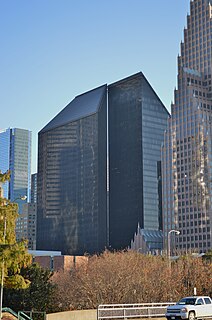Related Research Articles

Frank Lloyd Wright was an American architect, designer, writer, and educator. He designed more than 1,000 structures over a creative period of 70 years. Wright played a key role in the architectural movements of the twentieth century, influencing architects worldwide through his works and hundreds of apprentices in his Taliesin Fellowship. Wright believed in designing in harmony with humanity and the environment, a philosophy he called organic architecture. This philosophy was exemplified in Fallingwater (1935), which has been called "the best all-time work of American architecture".

Ralph Adams Cram was a prolific and influential American architect of collegiate and ecclesiastical buildings, often in the Gothic Revival style. Cram & Ferguson and Cram, Goodhue & Ferguson are partnerships in which he worked. Cram was a fellow of the American Institute of Architects.

Sir James Frazer Stirling was a British architect.
Euine Fay Jones was an American architect and designer. An apprentice of Frank Lloyd Wright during his professional career, Jones is the only one of Wright's disciples to have received the AIA Gold Medal (1990), the highest honor awarded by the American Institute of Architects. He also achieved international prominence as an architectural educator during his 35 years of teaching at the University of Arkansas School of Architecture.

Richard George Rogers, Baron Rogers of Riverside was a British architect noted for his modernist and functionalist designs in high-tech architecture. He was a senior partner at Rogers Stirk Harbour + Partners, previously known as the Richard Rogers Partnership, until June 2020.

The architecture of Houston includes a wide variety of award-winning and historic examples located in various areas of the city of Houston, Texas. From early in its history to current times, the city inspired innovative and challenging building design and construction, as it quickly grew into an internationally recognized commercial and industrial hub of Texas and the United States.

The Rice, formerly the Rice Hotel, is an historic building at 909 Texas Avenue in Downtown Houston, Texas, United States. The current building is the third to occupy the site. It was completed in 1913 on the site of the former Capitol building of the Republic of Texas, and is listed on the National Register of Historic Places. The old Capitol building was operated as a hotel until it was torn down and replaced by a new hotel around 1881. Jesse H. Jones built a new seventeen-story, double-winged hotel in 1913, also called "The Rice Hotel." This building underwent major expansions: adding a third wing in 1925, adding an eighteenth floor in 1951, and adding a five-story "motor lobby" in 1958. In addition, there were several renovations during its life as a hotel. It continued to operate as a hotel before finally shutting down in 1977. After standing vacant for twenty-one years, The Rice was renovated as apartments and reopened in 1998 as the Post Rice Lofts. It was sold in 2014 and renamed simply The Rice.

Pennzoil Place is a set of two 36-story towers in Downtown Houston, United States. designed by Philip Johnson/John Burgee Architects from a concept by Eli Attia, a staff architect with the firm. Completed in 1976, it is Houston's most award-winning skyscraper and is widely known for its innovative design.

Kevin Kennon is an American architect. Kennon is the Director of the Institute for Architecture and Urban Studies and is a founding principal of United Architects, a finalist in the prestigious 2002 World Trade Center Design Competition organized by the Lower Manhattan Development Corporation.

Rice University contains eleven residential colleges which function as the primary housing, dining, and social organizations for undergraduate students. The system was established in 1957 and was inspired by the residential college systems at the University of Oxford and the University of Cambridge as well as the American adaptations of the same at Harvard and Yale. Each student is randomly affiliated with a residential college upon matriculation and becomes a lifetime member of the college. The residential college system takes the place of a Greek system and has contributed to a sense of community that other universities have sought to emulate.
Karl Kamrath was an American architect and tennis player. He, along with Frederick James MacKie, Jr., created the Houston-based architectural firm Mackie and Kamrath. The firm's buildings reflected the principles of Organic Architecture and Usonian architecture, an outcome of Kamrath's friendship with Frank Lloyd Wright. His career spanned over five decades during which he designed residential, commercial, institutional and government buildings. Prior to founding MacKie and Kamrath, Karl Kamrath worked for Pereira and Pereira, the Interior Studios of Marshall Field and Company, and the Architectural Decorating Company in Chicago, Illinois.

Alfred Charles Finn was an American architect. He started in the profession with no formal training in 1904 as an apprentice for Sanguinet & Staats. He worked in their offices in Dallas, Fort Worth, and Houston. His credits during his tenure residential structures, but firm was a leader in steel-frame construction of skyscrapers.
William Ward Watkin was an architect primarily practicing in Houston, Texas. He was the founder of the Architecture Department of Rice University in 1912, and remained on the Rice faculty until his death. Concurrently, he also designed a number of important projects, mostly in the Houston area.
FKP Architects is an American architecture firm based in Houston, Texas. It specializes in the design of major academic, research, scientific, and healthcare projects. In 2017, FKP Architects merged with CannonDesign, a global architecture, engineering and planning firm.

Arthur Dyson is an American architect.
Howard Barnstone was a Houston-based American architect. He was best known for his work with Mark Rothko on the Rothko Chapel, and for the houses and public buildings he designed with Preston M. Bolton and Gene Aubry in the 1950s and 1960s, largely in Houston and Galveston. Barnstone attended Yale College and the Yale School of Architecture, from which he received a Bachelor of Architecture in 1948. He was a professor at the University of Houston College of Architecture and Design for more than thirty years. From 1952 to 1961, Barnstone was a partner in Bolton & Barnstone, one of Houston´s most public modern architectural firms at the time; the firm became Barnstone and Aubry (1966-1970) after he partnered with Aubry, his former student. Architectural historian Stephen Fox characterized Barnstone's approach as one committed to personal vision, free inquiry, and delight over orthodoxy or conventional wisdom, resulting in diverse buildings that combined proportional grace with wit and charm, and diminutive scale with spatial expansiveness.
Arthur Wallace Rice, FAIA was a prominent architect in Boston during the early 20th Century as a major contributor to the Beaux-Arts architectural movement in America. In his early years in partnership with William Y. Peters, he focused on large residences in the Back Bay neighborhood of Boston, primarily in the Georgian Revival style. As a partner in the firm of Parker, Thomas & Rice, he produced a number of landmark buildings and early skyscrapers in the Beaux-Arts style. Near the end of his career, his 1929 United Shoe Machinery Corporation Building in Boston was notable as one of the first skyscrapers in America to be built in the Art-Deco style that would become very popular in the following two decades.
Ralph A. Anderson Jr. was an architect, based in Houston, Texas, USA. After completing his B.A. in Architecture at Rice University in 1943, he served in the United States Infantry in the European Theatre of Operations. He received a head wound at the Battle of the Bulge, and was consequently awarded both the Purple Heart and the Bronze Star. He became partner in the firm Wilson, Morris, Crain & Anderson in 1952, which had become just Crain and Anderson by 1978. Anderson retired in 1988.
Courtlandt Place, Houston is a residential subdivision consisting of a single street, south of downtown Houston, planned in 1906. Courtlandt Place is a member of the Neartown Houston Association.

Eugene Edwards Aubry is an American architect, based primarily in Houston, Texas and later in Orlando, Florida. He is best known for the public buildings and houses he designed and co-designed in Houston, notably the Rice Museum at Rice University and the Alfred C. Glassell School of Art at the Museum of Fine Art Houston, the Rothko Chapel, and Wortham Center. Architecture writers credit the Art Barn's industrial aesthetic with inspiring Houston's so-called "Tin House" movement, as well adaptations by Frank Gehry. Aubry was partners with two other well-known Houston architects, Howard Barnstone and S.I. Morris, and worked on projects with Philip Johnson before starting his own firm, Aubry Architects in Sarasota, Florida in 1986. He completed the Rothko Chapel after artist Mark Rothko clashed with Johnson, who was the original architect.
References
- 1 2 "Guide to the Arthur E. Jones Architectural Records". Woodson Research Center, Fondren Library, Rice University. Archived from the original on August 14, 2014. Retrieved July 31, 2014.
- ↑ Koush, Ben. "The Modern Mr. Jones: A Legendary Houston Architect Shares His Tall Building Portfolio" (PDF). Cite: The Architecture + Design Review of Houston. Rice Design Alliance. 72 (Fall 2007). ISSN 8755-0415 . Retrieved July 31, 2014.